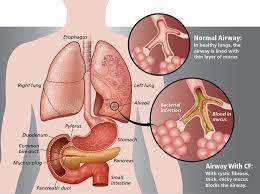Cystic Fibrosis: Understanding the Disease, Treatment, and Research Advances
---
**Introduction**
Cystic fibrosis (CF) is a genetic disorder that primarily affects the lungs and digestive system. It's a chronic, progressive condition that requires lifelong management and care. In recent years, significant progress has been made in understanding the disease, improving treatments, and advancing research towards potential cures. This article aims to delve into the complexities of cystic fibrosis, exploring its causes, symptoms, treatments, and the latest developments in the field.
**Understanding Cystic Fibrosis**
Cystic fibrosis is caused by mutations in the CFTR (Cystic Fibrosis Transmembrane Conductance Regulator) gene. This gene provides instructions for making a protein that regulates the movement of salt and water in and out of cells. When the CFTR gene is mutated, it leads to the production of a defective CFTR protein or no protein at all. As a result, the secretions in various organs become thick and sticky, particularly affecting the lungs, pancreas, liver, intestines, sinuses, and sex organs.
The thick mucus clogs the airways in the lungs, making it difficult to breathe and trapping bacteria, leading to frequent lung infections and inflammation. In the pancreas, the mucus obstructs the ducts, preventing digestive enzymes from reaching the intestines and impairing the absorption of nutrients. This can result in malnutrition and poor growth, especially in children.
**Symptoms and Diagnosis**
Symptoms of cystic fibrosis vary widely depending on the severity of the disease and the organs affected. Common signs and symptoms include:
1. Persistent cough with thick mucus
2. Frequent lung infections, such as pneumonia or bronchitis
3. Wheezing or shortness of breath
4. Poor growth and weight gain despite a good appetite
5. Salty-tasting skin
6. Difficulty in bowel movements or fatty stools
Diagnosing cystic fibrosis typically involves a combination of sweat tests, genetic testing, and evaluating symptoms. The sweat test measures the amount of salt in sweat, which is usually elevated in individuals with CF due to the dysfunction of the CFTR protein. Genetic testing identifies mutations in the CFTR gene, providing a definitive diagnosis.
**Treatment and Management**
While there is currently no cure for cystic fibrosis, advancements in treatment have significantly improved the quality of life and life expectancy for individuals with the condition. The goals of treatment are to alleviate symptoms, prevent complications, and slow the progression of the disease.
**1. Airway Clearance Techniques:** These techniques help loosen and remove mucus from the lungs, reducing the risk of infections and improving lung function. They may include chest physiotherapy, percussion, vibration, and breathing exercises.
**2. Medications:** Various medications are used to manage symptoms and complications of cystic fibrosis. Bronchodilators help open the airways, making it easier to breathe. Antibiotics are prescribed to treat lung infections, while mucolytics thin the mucus, making it easier to cough up.
**3. Pancreatic Enzyme Replacement Therapy (PERT):** PERT involves taking digestive enzymes with meals and snacks to aid in the breakdown and absorption of nutrients. This helps prevent malnutrition and supports healthy growth.
**4. Nutritional Support:** A well-balanced diet, high in calories and nutrients, is essential for individuals with cystic fibrosis to maintain optimal health. Some may require additional supplements or tube feeding if they struggle to meet their nutritional needs.
**5. Lung Transplantation:** In severe cases where lung function continues to decline despite treatment, lung transplantation may be considered as a last resort. This involves replacing the diseased lungs with healthy donor lungs, offering a chance for improved lung function and quality of life.
**Recent Advances in Research**
In recent years, significant progress has been made in cystic fibrosis research, leading to promising advancements in treatment and potential cures. One notable breakthrough is the development of CFTR modulator therapies, which target the underlying cause of the disease by improving the function of the defective CFTR protein.
**1. CFTR Modulator Therapies:** These medications, such as ivacaftor, lumacaftor, tezacaftor, and elexacaftor, are designed to correct specific defects in the CFTR protein, leading to improved salt and water transport across cell membranes. This helps thin the mucus, reduce inflammation, and improve lung function. CFTR modulators have revolutionized the treatment of cystic fibrosis, significantly improving outcomes for patients with certain mutations.
**2. Gene Editing Technologies:** Emerging gene editing technologies, such as CRISPR-Cas9, hold promise for correcting the underlying genetic mutations responsible for cystic fibrosis. Researchers are exploring ways to deliver these gene-editing tools directly to the affected cells, potentially offering a cure for the disease.
**3. Personalized Medicine:** Advances in genetic testing and precision medicine have enabled healthcare providers to tailor treatments to individual patients based on their specific genetic mutations. This personalized approach allows for more targeted and effective therapies, maximizing benefits while minimizing side effects.
**Conclusion**
Cystic fibrosis is a complex genetic disorder that affects multiple organs, primarily the lungs and digestive system. While there is currently no cure, significant progress has been made in understanding the disease, improving treatments, and advancing research towards potential cures. With the development of CFTR modulator therapies, gene editing technologies, and personalized medicine approaches, there is hope for a brighter future for individuals living with cystic fibrosis. Continued investment in research and innovation is crucial to further improving outcomes and ultimately finding a cure for this debilitating disease.
---
**References:**
1. Cutting, G. R. (2015). Cystic fibrosis genetics: from molecular understanding to clinical application. Nature Reviews Genetics, 16(1), 45-56.
2. Elborn, J. S. (2016). Cystic fibrosis. The Lancet, 388(10059), 2519-2531.
3. Davies, J. C., Alton, E. W., & Bush, A. (2007). Cystic fibrosis. British Medical Journal, 335(7632), 1255-1259.
4. Wainwright, C. E., Elborn, J. S., & Ramsey, B. W. (2015). Lumacaftor–Ivacaftor in patients with cystic fibrosis homozygous for Phe508del CFTR. New England Journal of Medicine, 373(18), 1783-1784.
5. Veit, G., Avramescu, R. G., & Cholon, D. M. (2016). From CFTR biology toward combinatorial pharmacotherapy: expanded classification of cystic fibrosis mutations. Molecular Biology of the Cell, 27(3), 424-433.


